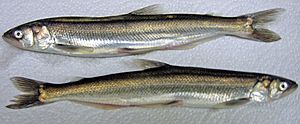Eulachon facts for kids
Quick facts for kids Eulachon |
|
|---|---|
 |
|
| Scientific classification |
The eulachon (Thaleichthys pacificus), also called oolichan or candlefish, is a small fish that lives in the Pacific Ocean. These fish are special because they swim from the ocean into freshwater rivers to lay their eggs. This journey happens along the Pacific coast of North America, from northern California all the way up to Alaska.
Contents
Why is it called a Candlefish?
The name "candlefish" is quite interesting! It comes from the fact that these fish are very, very fatty, especially when they are ready to lay their eggs. Up to 15% of their body weight can be fat. Because of all this fat, if you catch, dry, and string an eulachon on a wick, it can actually be burned like a candle! Early explorers often used this name.
The name eulacheon comes from the Chinookan languages, which are spoken by some Native American groups. Some people believe that the name of the state of Oregon might even come from a Native American trade route called the "Ooolichan Trail," which was used to trade eulachon oil.
What does the Eulachon look like?
Eulachon are special because they have large, canine-like teeth on a bone in the roof of their mouth. They also have many rays (like thin bones) in their bottom fin. Like salmon and trout, they have a small, fleshy fin called an adipose fin behind their main back fin. This fin is shaped like a sickle.
Male eulachon have longer paired fins than females. When it's time to lay eggs, males also develop raised bumps on their fins and fleshy ridges along their bodies. Adult eulachon are reddish to blue on their backs and heads. Their sides are lighter, silvery-white or light blue, and their bellies are white. They have very fine spots on their backs.
These fish can grow up to about 12 inches (30 cm) long. However, most adult eulachon are usually between 6 and 8 inches (15 and 20 cm) long. While they are in the ocean, they eat tiny ocean creatures called plankton.
Eulachon's Life and Food Chain
Eulachon mainly eat plankton, but they also munch on fish eggs, small bugs, and tiny ocean crustaceans. They are a very important food source for many animals that live in the ocean and along the shore. They are also a key food for people who live near the rivers where eulachon lay their eggs.
Eulachon are what we call anadromous fish. This means they spend most of their adult lives in the ocean. But when it's time to reproduce, they swim back to the same freshwater rivers and streams where they were born. After they lay their eggs, they die.
Because of this, one river might have huge numbers of eulachon swimming upstream, while a nearby river might have very few. Scientists don't fully understand why the numbers change so much from year to year or why some rivers have more fish than others. When the eulachon start their journey upriver, the first fish are almost all males. The females follow later, about halfway through the run.
Eulachon and People

For a very long time, Native American communities along the Pacific Coast, from California to Alaska, relied on eulachon as a major part of their food. They also traded eulachon with groups who lived further inland and didn't have access to these fish. People caught eulachon using traps, rakes, and nets.
Today, people still harvest eulachon. The fish are often frozen to be used later. They can also be dried, smoked, or canned.
One of the most important products made from eulachon was their rich oil, sometimes called "eulachon grease." To make this oil, people would let the fish decompose (rot) for about a week in a hole in the ground. Then, they would add boiling hot water. The oil, being lighter than water, would rise to the top and could be skimmed off. This eulachon oil was a very valuable trade item with communities living away from the coast. The paths used for this trade became known as grease trails.
Besides food and oil, eulachon were also used as bait for sportfishing and as food for pets like cats and dogs.
Protecting the Eulachon
In 2008, the Cowlitz Tribe asked the National Marine Fisheries Service (NMFS) to protect the eulachon population in Washington, Oregon, and California. They wanted these fish to be listed as an endangered or threatened species under the Endangered Species Act.
After looking into it, the NMFS agreed that the eulachon needed protection. So, on March 16, 2010, the southern group of eulachon was officially listed as a "threatened" species. This means they are likely to become endangered in the future if steps are not taken to protect them.
In 2017, a recovery plan was approved. This plan acts like a guide, using the best scientific information available, to help protect and bring back the southern eulachon population.
See also
 In Spanish: Eulacon para niños
In Spanish: Eulacon para niños

